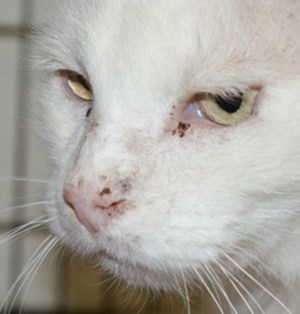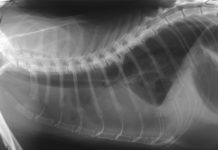Nose pad cancer in cats is a malignant kind of tumor, which mainly affects the squamous epithelial cells in a cat nose.
This disease, also known sometimes as Squamous cell carcinoma, is a kind of tumor of the nose pad tissues or nasal planum. It is more common in cats, rather than in dogs.
Exposure to chemicals in the air may increase the risk of nasal tumors. This could be through inhaling cigarette smoke, air fresheners aerosols, or smokes from the fireplace- all the things which can also cause problems in us!
In this article, we will discuss some more interesting facts about nose pad cancer in cats including its causes, symptoms, prognosis, and treatment.
What is Nose Pad Cancer in Cats?

Nose pad cancer is curable if it’s treated and is diagnosed at an early stage. Examine your pet’s face from time to time to see if there is any presence of scabs or sores. If there’s anything obvious, seek speedy vet treatment!
The most typical form of cat nose cancer is squamous cell carcinoma. This condition manifests as small sores with some scabs, which tend to be irregularly shaped and flat. Lacerations may be present, and the affected area might be pink in color and hairless.
The marks may appear harmless and may even vanish for a period. However, when left untreated, the lesions may come back and may start seeping and become swollen. Also, cancer might metastasize to other parts of the body.
Causes
Besides chemical inhalation over time, the main cause of nose pad cancer in cats is excessive exposure to UV rays. Cats that spend a lot of time lying in sunlight may be more vulnerable to nose pad cancer.
Some other possible causes of this condition include the following:
- Exposure to inhaled irritants
- Certain kinds of virus
- Serious burn
- Physical trauma
Symptoms
The main symptom of nose pad cancer is the existence of scab-like protrusions. Some other symptoms of the condition may include the following:
- Seizure
- Behavioral changes
- Disorientation
- Inflammation and swelling in the area affected
- Discharge from the eyes or nose
- Nosebleeds
- Reverse sneezing
- Sneezing
- Breathing via the mouth
Prognosis

The treating vet will discuss with you the details regarding the onset and severity of the symptoms, as well as reviewing the medical records of the cat. Additionally, standard lab tests may be ordered as well.
Tests usually include urinalysis, biochemistry profile, and complete blood count, to evaluate the overall health of the cat.
Also, a complete physical examination may be done as the veterinarian tries to rule out some other possible causes like dental disease, viral infection, or bacterial infection.
Moreover, a conclusive prognosis might be made by way of removing the fluid and tissue samples under general anesthesia and sending them to the laboratory for a biopsy.
Treatment for nose pad cancer in cats
If the problem is caught in the early stages there will be more treatment options available.
In some cases, the veterinarian may recommend a consultation with a vet oncologist and they will determine the course of action.
Possible treatment options include:
Chemotherapy
In some instances, your pet might benefit from various chemotherapy treatments for cats. Your vet will be sure to tell you everything you need to know, the pros and cons, and what it will cost you.
Radiation Therapy
Radiation therapy is most effective if there are many lesions, which haven’t spread through the deeper layers of the skin of the cat. It might also be recommendable when the lesions have progressed already.
Surgical Removal
The treating vet might suggest surgical removal of the tumor. A healthy tissue border or margin may be removed to make sure that the whole tumor has been removed!
Cryotherapy
This particular procedure seeks to remove the cancer cells by freezing them at very low temperatures. However, this is a less common treatment method.
How to help cats with cancer
Hopefully, your cat is at a stage where it’s illness can be treated.
Always keep an eye on your cat’s mood, appetite, and physical condition to ensure you get on top of any problems like this early. Find out the signs of a healthy cat. There’s nothing worse than finding out that if you’d noticed things a little earlier you could have saved your pet’s life!









